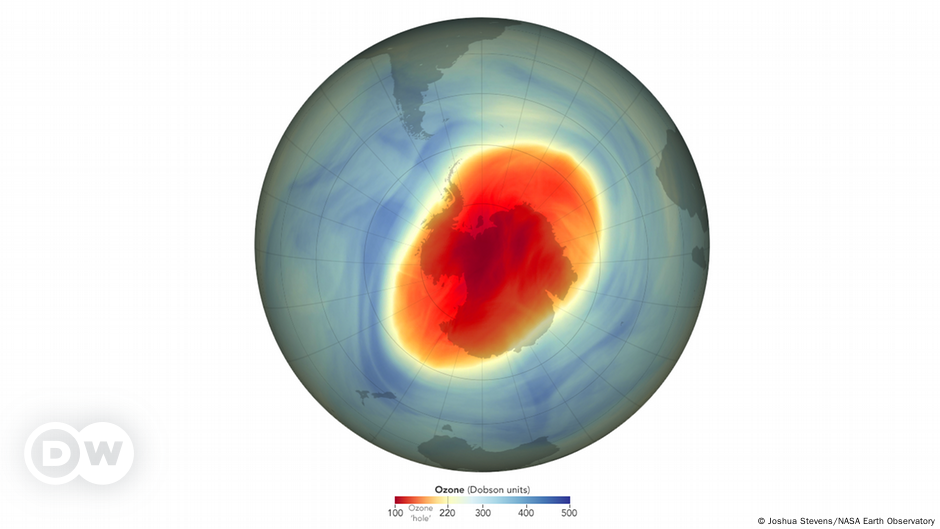
It may just be a thin layer of gas but it protects life on earth. The global attempt to repair it is one of the greatest environmental success stories. In the 1980s, the ozone layer — or lack of it — loomed large in the public imagination, as scientists warned its continued destruction could be catastrophic for humanity and the planet.
It led to what is seen as one of the most successful environmental agreements ever which set out to reverse the damage. So why are holes still appearing ? And what does ozone have to do with climate change? What is the ozone layer? Essentially it is Earth's sunscreen. Located around 15-30 kilometers (about 9-18 miles) above the planet's surface in the stratosphere, the layer is formed by ozone, a highly reactive gas.

It may only be on average 3mm (about 0.12 in) thick, but it protects all living things by absorbing and scattering two types of UV radiation from the sun. Without it we would be in serious trouble: humans would experience more skin cancer, eye problems and weakened immune systems, crop yields would suffer due to damaged plant growth and marine food chains would be disrupted.
It was back in the 1980s that scientists discovered chlorofluorocarbons (CFCs) — man-made gases released by aerosols such as hairspray, as well as refrigerators, air conditioners and insulating foams — were damaging the ozone. These CFCs were found to float up to the stratosphere, where UV exposure breaks them down into substances such as chlorine which then rip apart ozone molecules. This causes the protective layer to thin out and be described, slightly misleadingly, as the ozone "hole" .
It happens above Antartica because lower temperatures speed up this chemical process. Have we managed to save it? Amidst a glut of gloomy environment stories, the ozone layer offers a glimmer of optimism. The Montreal Protocol, finalized in 1987, was a global agreement designed to get rid of ozone-depleting substances (ODSs) from the atmosphere.
So far 99% of ODSs have been phased out and an estimated 2 million annual cases of skin cancer have potentially been avoided thanks to the protocol. "Thanks to a global agreement, humanity has averted a major health catastrophe due to ultraviolet radiation pouring through a massive hole in the ozone layer," said UN Secretary-General Antonio Guterres, last year. That doesn't mean the ozone hole is yet a thing of the past.
It still appears annually above Antartica , fluctuating in size and shape due to changes in stratospheric temperature and circulation. In recent years it has also been notably large. A hole that appeared in September 2023 was one of the largest on record, reaching 26 million sq km (over 10 million sq miles) — an area roughly three times the size of Brazil.
While scientists cannot yet fully explain this, they believe aerosols from a massive volcanic eruption in the South Pacific in 2022 and cooling in the upper stratosphere due to climate change may have played a role. And what they are clear on is that these are anomalies in a general trend of recovery. The ozone layer is expected to recover to its 1980 global average within the next two decades, and by 2066 in the Antarctic and 2045 in the Arctic.
What does the ozone layer have to do with climate change? Without the Montreal Protocol, we may be looking at an extra 2.5C warming by the end of the century, according to a 2021 study published in the journal Nature. Efforts to save the ozone layer have helped slow climate change because many ODSs are potent greenhouse gases.
The Montreal Protocol has avoided an estimated 135 billion tons of carbon dioxide equivalent emissions from 1990 to 2010. And without the ozone protecting plants from damaging UV radiation, there would have been 580 billion tons less carbon stored in forests, other vegetation and soils. The protocol was further aided by the Kigali Amendment in 2016 which phased out hydrofluorocarbons (HFCs), potent greenhouse gases used in many refrigerators and air conditioners as CFC replacements.
The scale and speed of international action to save the ozone layer is seen by some as inspiring evidence of what is possible for tackling the climate crisis . However, a 2023 UN report also warned that novel climate fighting technologies such as geoengineering may have negative impacts on the ozone layer. A form of geoengineering known as stratospheric aerosol injection — which pumps sunlight reflecting gas into the atmosphere to reduce global heating — may change "stratospheric temperatures, circulation and ozone production," and therefore contribute to "destruction rates.
" Antarctica: world’s largest iceberg on the move To view this video please enable JavaScript, and consider upgrading to a web browser that supports HTML5 video Edited by: Tamsin Walker.










